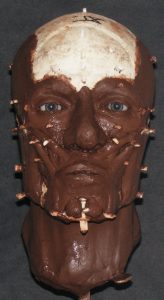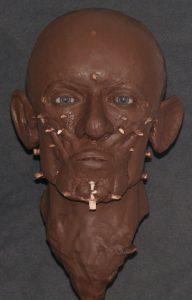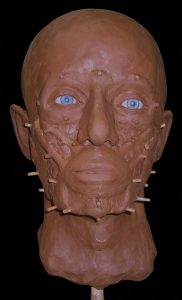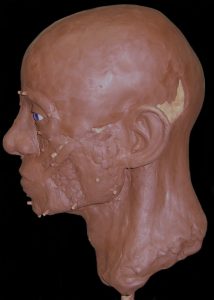Forensic facial reconstruction is a process that aims to assist in the identification of a deceased individual whose only clue to identity is their human remains, in this case a skull. Reconstruction is based on scientific information acquired from the skull and its details. By completing a morphological assessment, it is possible to determine sex, ancestral background and a rough age of the individual. This is made more challenging if there are missing bones on the face or only a few or no teeth.
There are certain traits on the skull that tell you whether the skull belong to male or female; for example, larger size in general and rougher surface of the skull, indicating bigger muscles, are male traits, while a more gracile size and smoother surface of the muscle attachment sites indicate a female.
Age determination is carried out largely from the eruption and condition of the teeth. The estimation range is narrower for children due to more specific tooth eruption times but for adults the range is wider. The amount of wear in the teeth is a good guide though and age range can be estimated from several dental tables available. In addition to this, cranial sutures offer useful information, however this is not as accurate as assessing teeth. For example, faded sutures usually indicate an older individual, however the sutures can remain clear until the old age in some individuals.
People look different based on their geographical origin because skulls and surface information (skin tone, hair colour) have evolved over time to adapt to different climates and environments. These differences are visible in the details of a skull, for example the shape of the nasal aperture or teeth or profile of the skull which for example with African origin is generally more protruding around the mouth compared to a European skull whose profile tends to be more upright. In physical anthropology and forensic art having separate ancestral groups such as Asian, African, European and Australian aboriginal is essential to recreate the appearance of an individual as accurately as possible. This becomes more challenging of course with mixed race individuals in which case having DNA information increases accuracy further.
Facial Reconstruction with the Manchester Method
This method emphasises a scientific and anatomically correct approach to constructing a human face. It is possible to estimate the approximal size of the facial muscles based on the details of the skull and bone surface. These muscles are created first along with fat tissue and larger glands (parotid gland), which give shape to the face. Tissue depth pegs are attached to the skull (replica) to help with the estimation of the amount of soft tissue (muscles, fat, skin) required on the bone to build a face accurately. The length of the tissue depth pegs is based on average data of an ethnic group that matches the ethnicity of the individual. Artistic skills are required for the technical part of reconstructing the face but more importantly for creating a natural looking face that is easy to engage with for anyone who looks at the face.
Some pictures of the reconstruction process by manual sculpting (these are from the forensic art course therefore finished reconstructions are not allowed to be shown here)





